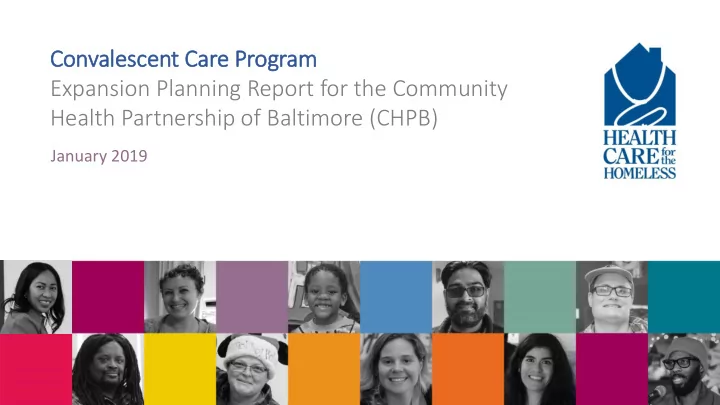

Convalescent Care Program Expansion Planning Report for the Community Health Partnership of Baltimore (CHPB) January 2019
Purpose of Report CHPB awarded us a grant to plan to expand our Convalescent Care Program (CCP). The last six months of 2019, we researched: 1. Hospital demand 2. Gaps in care 3. Location and facility type 4. Funding sources The findings will help guide expansion activities in 2020 and after.
Methodology We used the following sources to compile our report: Interviews • 11 staff members in case management and social work at six local hospitals: • 13 CCP clients interviews and 36 client surveys • Five CCP staff members • The Emergency Services Coordinator at the Mayor’s Office of Homeless Services CRISP utilization data Health Care for the Homeless client data (EHR)
What is Recuperative Care? HRSA defines recuperative care as: “ Short term care and case management provided to individuals recovering from an acute illness or injury that generally does not necessitate hospitalization, but would be exacerbated by their living conditions.”
The Triple Aim The Institute for Healthcare Improvement recommends a three- pronged approach to health care. Recuperative care addresses “ gaps in community services such as a shortage of affordable housing and a lack of safe hospital discharge options .” National Health Care for the Homeless Council
Current Program — Overview 1. 25 beds (7 for women and 18 for men) 2. Located above the Weinberg Housing and Resource Center (WHRC) 3. Staff provide behavioral, medical and supportive services • Medical providers • Therapy • Social work • Case management • Psychiatric occupational therapy
Current Program — Client Eligibility 1. Experiencing homelessness 2. At least 18 years old 3. Recovering from post-acute medical issue 4. Able to manage ADLs and medication 5. Able to stay in group environment We are not able to accommodate oxygen, IVS, or communicable diseases.
Impact 148 clients recuperated at CCP in 2019 80% were discharged to a community program, shelter or housing 94% of surveyed clients agreed or strongly agreed that “my health is improving here ”
Impact 79% of clients with hypertension reached controlled blood pressure 72% of clients saw a medical provider within seven days of Discharge.
Limits — Denials 75% of denials are because no beds Referral Denials Total No beds available 240 were available or we couldn’t connect Bed no longer needed or no follow-up from hospital 112 with the hospitals No acute need 40 Unable to perform ADLs 46 Risk of violence or disruptive 14 80% of the time we meet our 24-hour Banned from CCP or WHRC 7 Suicidal in last 30 days 4 referral response time, but that usually Requires isolation 4 Requires oxygen isn’t fast enough for hospital discharge 3 Other 3 timelines Total 473
Limits — Reimbursements Only 25% of all visits were reimbursable through Medicaid and Medicare Out of the 143 clients we saw in the first ten months of 2019: • 104 were insured through Medicaid • 20 through Medicare • 19 didn’t have insurance We currently cannot bill for: • Case management • Community health workers • Weekend nursing
Community Experience — Referrals During the first ten months of 2019, 671 clients were referred to CCP. Due to bed space and staffing, we accepted 198 of those referrals. • 19% of all referrals were accepted • 76% of CCP referrals come from local hospitals • 28% of people accepted into CCP did not make it to the program
Community Experience — Hospital Feedback Hospital staff helped us identified unmet needs and demand for services. Need Description Need Level Oxygen Clients who require two liters or less of oxygen per day High Chronic Disease Stabilizing and coordinating care for uncontrolled chronic High conditions Palliative Care End stage diseases; clients not yet hospice eligible Medium Influenza Short-term admission to recover from influenza Medium IV IVs for medication Low
Community Experience — Hospital Charges CRISP before/after hospital charges of clients in CCP in 2018. $10,135,752 12 months $10,873,218 $6,413,381 After 6 months $9,620,374 Before $3,600,108 3 months $6,495,301 $0 $2,000,000 $4,000,000 $6,000,000 $8,000,000 $10,000,000 $12,000,000 14
Community Experience — Hospital Charges Some clients visited the hospital more often after CCP; and still, their hospital charges decreased. • Johns Hopkins : +99 more visits and $1,326,190 less in charges • UMMC: + 19 more visits and $366,127 less in charges • Sinai Hospital: +14 more visits and $285,305 less in charges
2020 Opportunities Increase the number of beds 55 beds could result in 385 unique clients served per year — a 100% increase Shorten the referral wait time Full-time Referral Screener to improve communications with referral partners Ease eligibility requirements Offer oxygen and private spaces Add a standalone facility
2020 Opportunities — Proposed Standalone Facility Services 30 Beds • Two dorms: 8 men each • Post-acute medical issues • One dorm: 8 women • Chronic conditions (limited) • 6 private rooms with • Oxygen bathrooms • Isolation needs • 6 beds with oxygen concentrators
2020 Opportunities — Funding Strategies 1. Hospital collaboration 2. Medicaid waivers 3. Managed Care Organizations
2020 Opportunities — Payment Models 1. Per diem rate 2. Capitated per-member-per-month (PMPM) amount 3. One-time case rate 4. Monthly payment to reserve beds
QUESTIONS?
Recommend
More recommend